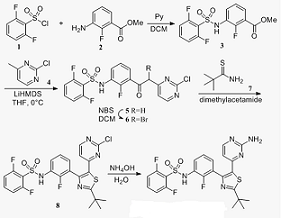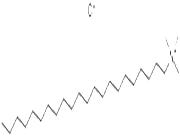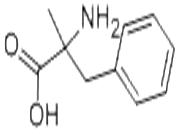| Description |
N-[3-[5-(2-Amino-4-pyrimidinyl)-2-(tert-butyl)-4-thiazolyl]-2-fluorophenyl]-2,6-difluorobenzenesulfonamide is well known as dabrafenib. It is a drug for the treatment of cancers associated with a mutated version of the gene BRAF. Dabrafenib acts as an inhibitor of the associated enzyme B-Raf, which plays a role in the regulation of cell growth. Dabrafenib has clinical activity with a manageable safety profile in clinical trials of phase-I and -II in patients with BRAF(V600)-mutated metastatic melanoma1,2. Its mechanism of action is acted as a Protein Kinase Inhibitor, and Cytochrome P450 3A4 Inducer, and Cytochrome P450 2B6 Inducer, and Cytochrome P450 2C8 Inducer, and Cytochrome P450 2C9 Inducer, and Cytochrome P450 2C19 Inducer, and Organic Anion Transporting Polypeptide 1B1 Inhibitor, and Organic Anion Transporting Polypeptide 1B3 Inhibitor, and Organic Anion Transporter 1 Inhibitor, and Organic Anion Transporter 3 Inhibitor, and Breast Cancer Resistance Protein Inhibitor3,4. It is not indicated for the treatment of patients with wild-type BRAF melanoma or wild-type BRAF NSCLC. MEKINIST is not indicated for the treatment of patients with melanoma who have progressed on prior BRAF-inhibitor therapy5. |
| Synthetic Methods |
The key step in the synthesis of Dabrafenib is the construction of the 1,3-thiazole ring, which is usually carried out by the closing ring directly of thioamide (as a 1,3-binuclear reagent) and anα-carbonyl halide (as a 1,2-amphiphilic reagent). Sulfonyl chloride 1 and aniline 2 gave sulfonamide 3 under basic conditions. Methyl pyrimidine 4 with non-nucleophilic strong alkali LiHMDS pull out the acid proton on the methyl and react with 3 to obtain 5, and the latter has α-bromination with NBS to obtain 1,2-amphiphilic reagent 6, and then 6 reacts with 1 , 3-parent nucleotides 7 to close the ring to obtain 8, and finally reacts with ammonia to obtain Dabrafenib.
 |

 China
China



![N-[3-[5-(2-Amino-4-pyrimidinyl)-2-(tert-butyl)-4-thiazolyl]-2-fluorophenyl]-2,6-difluorobenzenesulfonamide](https://img.chemicalbook.com/ProductImageEN/2018-8/Large/639db4b1-b54a-4fa2-bda0-303e3445dcb7.gif)
![N-[3-[5-(2-Amino-4-pyrimidinyl)-2-(tert-butyl)-4-thiazolyl]-2-fluorophenyl]-2,6-difluorobenzenesulfonamide Structure](https://www.chemicalbook.com/CAS/GIF/1195765-45-7.gif)



